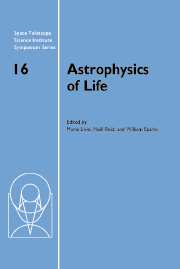 Astrophysics of Life
Astrophysics of Life Published online by Cambridge University Press: 29 August 2009
Galactic scale phenomena relevant to life on a terrestrial planet are reviewed. The habitability of the Earth for complex life is surprisingly dependent on a diverse collection of processes ranging from Galactic chemical evolution to Galactic nuclear activity to comet impacts. The combined effect of these is to restrict the time and space that complex life can exist on a terrestrial planet. That region in the Milky Way is termed the Galactic Habitable Zone.
Introduction
The introduction of the Circumstellar Habitable Zone (CHZ) concept in the late 1950s (Huang 1959) and later refinements (Hart 1979; Kasting et al. 1993; Franck et al. 2000) have permitted the study of life in the universe to be systematized to some degree. However, discussion of habitability on the scale of the Milky Way Galaxy has received less attention. Trimble (1997a) considered habitability in the context of Galactic chemical evolution. Clarke (1981) discussed the possible effects on habitability of a Seyfert-like outburst in the Galactic center. In addition, many papers have been written about the possible threats to life by nearby supernovae (e.g. Ellis & Schramm 1995). While these studies have been helpful studies, they do not attempt to systematize the concept of habitability on the Galactic scale.
Before beginning any discussion about habitability, it is important to be up front about assumptions regarding life. As in CHZ studies, we assume Earth-like life in exploring Galactic-scale habitability constraints.
To save this book to your Kindle, first ensure [email protected] is added to your Approved Personal Document E-mail List under your Personal Document Settings on the Manage Your Content and Devices page of your Amazon account. Then enter the ‘name’ part of your Kindle email address below. Find out more about saving to your Kindle.
Note you can select to save to either the @free.kindle.com or @kindle.com variations. ‘@free.kindle.com’ emails are free but can only be saved to your device when it is connected to wi-fi. ‘@kindle.com’ emails can be delivered even when you are not connected to wi-fi, but note that service fees apply.
Find out more about the Kindle Personal Document Service.
To save content items to your account, please confirm that you agree to abide by our usage policies. If this is the first time you use this feature, you will be asked to authorise Cambridge Core to connect with your account. Find out more about saving content to Dropbox.
To save content items to your account, please confirm that you agree to abide by our usage policies. If this is the first time you use this feature, you will be asked to authorise Cambridge Core to connect with your account. Find out more about saving content to Google Drive.